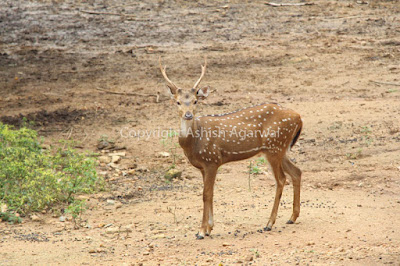Spotted Grace: The Timeless Beauty of the Indian Chital (Spotted Deer)
In the image above, a spotted deer, or chital, stands in silent alertness on the forest floor.
Its body is marked with elegant white spots against a reddish-brown coat. Its antlers curve upward with gentle strength. Around it lies dry earth and scattered greenery—its natural habitat, unbothered and wild.
This isn't just a photograph.
It's a moment.
A quiet frame in the never-ending rhythm of the jungle—where survival meets grace and the ordinary becomes extraordinary.
A Closer Look at the Chital: Nature's Masterpiece
The spotted deer (Axis axis) is one of the most recognized and beloved animals in Indian forests.
-
Coloration: Reddish-brown with distinctive white spots running along its flanks and back. These spots remain through life, unlike some deer species that only have them as fawns.
-
Antlers: Only the males grow antlers, which usually have three tines and can grow impressively long.
-
Size: Adult males can weigh between 70 to 85 kg and stand about 90 cm at the shoulder. Females are smaller, more slender.
-
Eyes and Ears: Large, expressive eyes and constantly twitching ears help the chital stay alert in its predator-rich ecosystem.
Its appearance combines the elegance of form with the efficiency of evolution—a creature built for both beauty and survival.
The Social Life of the Spotted Deer
Chitals are highly social animals. They live in herds that often consist of 10–30 individuals but can sometimes number in the hundreds, especially in regions with abundant water and food.
-
Group Structure: A herd usually includes females, fawns, and a few males. Older males may roam alone or form bachelor groups.
-
Vocalization: They are known to produce sharp barks, especially when alarmed—often warning other animals of predators like tigers or leopards.
-
Mutualism: Interestingly, chitals are often seen alongside langurs (monkeys). The monkeys drop fruit from trees, and in return, the deer alert them of ground threats.
This behavior shows that cooperation across species isn’t just human—it thrives in the wild too.
Habitat and Distribution
The spotted deer is native to the Indian subcontinent. It is widely distributed across:
-
India (from the Himalayan foothills to the southern forests)
-
Sri Lanka, Nepal, and Bangladesh
Chitals prefer dry deciduous forests, grasslands, and open plains near water bodies. They are grazers and browsers—eating grass, leaves, and fruits.
National parks where you're most likely to see them include:
-
Kanha National Park
-
Bandipur Tiger Reserve
-
Ranthambore National Park
-
Jim Corbett National Park
-
Bandhavgarh and Pench Tiger Reserves
They are also found in protected city forests, often calmly crossing park roads or grazing near forest rest houses.
Fawns and Family
The birth of a chital fawn is a quiet miracle in the wild.
-
Breeding occurs year-round, though there’s a peak during monsoons.
-
After a gestation of about 7–8 months, a female gives birth to a single fawn.
-
The fawn is born with spots and begins walking within minutes.
-
For the first few weeks, it stays hidden in tall grass while the mother grazes nearby.
These early days are critical—danger lurks at every corner from leopards, wild dogs, and snakes.
Despite this, chital populations have remained relatively healthy thanks to their adaptability, speed, and group dynamics.
The Spotted Deer in Popular Culture
The beauty of the chital hasn’t gone unnoticed by filmmakers, photographers, and writers.
In Cinema & Documentaries:
-
Spotted deer frequently appear in BBC nature documentaries, often in scenes involving tiger stalking sequences in Indian jungles.
-
In The Jungle Book (Disney and Rudyard Kipling), while the deer is not named, its presence sets the stage for the predator-prey dynamics of the forest.
-
Indian wildlife documentaries, including those by Valmik Thapar and Bittu Sahgal, often showcase chital herds to illustrate healthy jungle ecosystems.
Symbolism and Storytelling:
In Indian mythology, deer often symbolize gentleness and grace.
In some Buddhist and Jain traditions, the deer represents peace, kindness, and the absence of ego.
It is an animal that, despite its vulnerability, walks the earth with quiet dignity.
Why We Love the Chital: An Abstract Appreciation
For viewers who enjoy abstract images and symbolism, this deer stands for more than its physical form.
-
The spots echo constellations—tiny stars sprinkled across the canvas of its coat.
-
The antlers, symmetrical yet unique, suggest growth, branching out, and nature’s geometric artistry.
-
The stance—alert yet calm—embodies mindfulness, being fully present in the moment.
In abstract art and thought, the chital reminds us of the balance between awareness and grace.
It shows that beauty doesn’t always need to be loud or aggressive—it can stand quietly and still capture every eye.
Want to get tips for improving your photography ? Get Photo Tips from this blog.

 RSS
RSS

0 comments:
Post a Comment